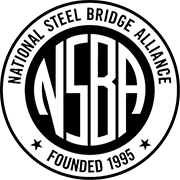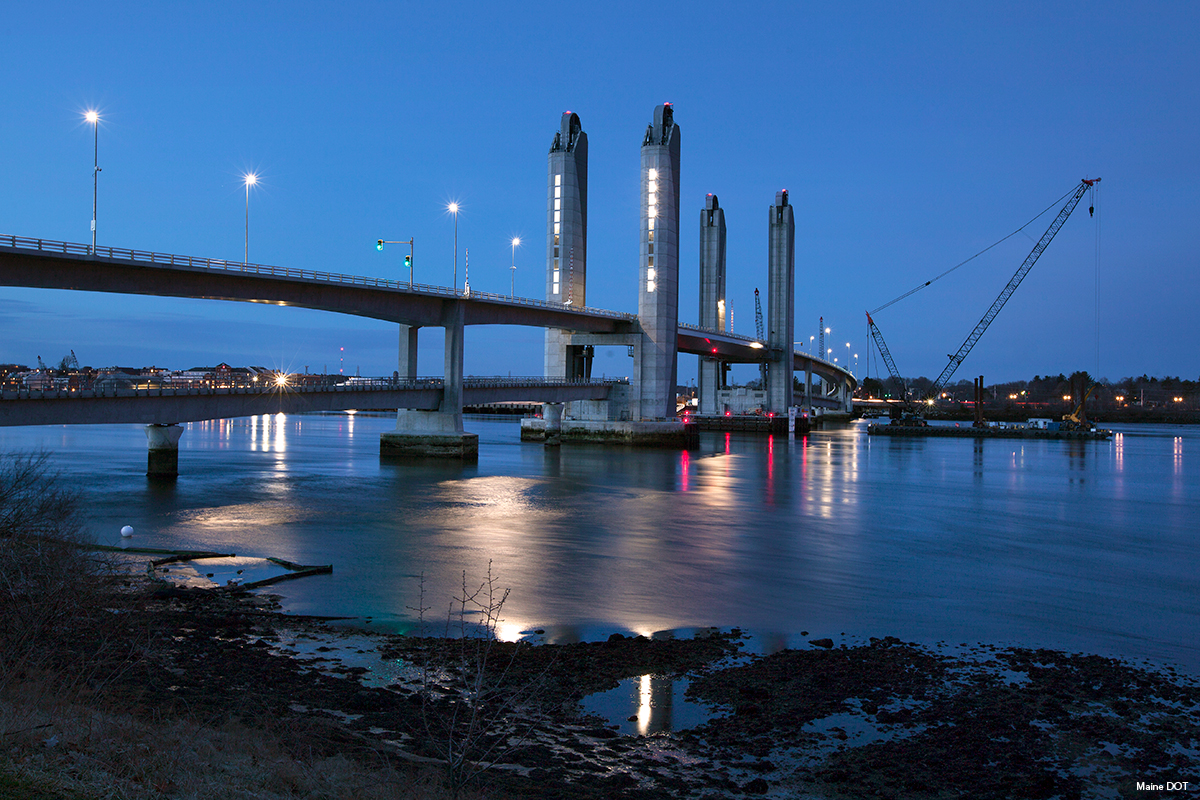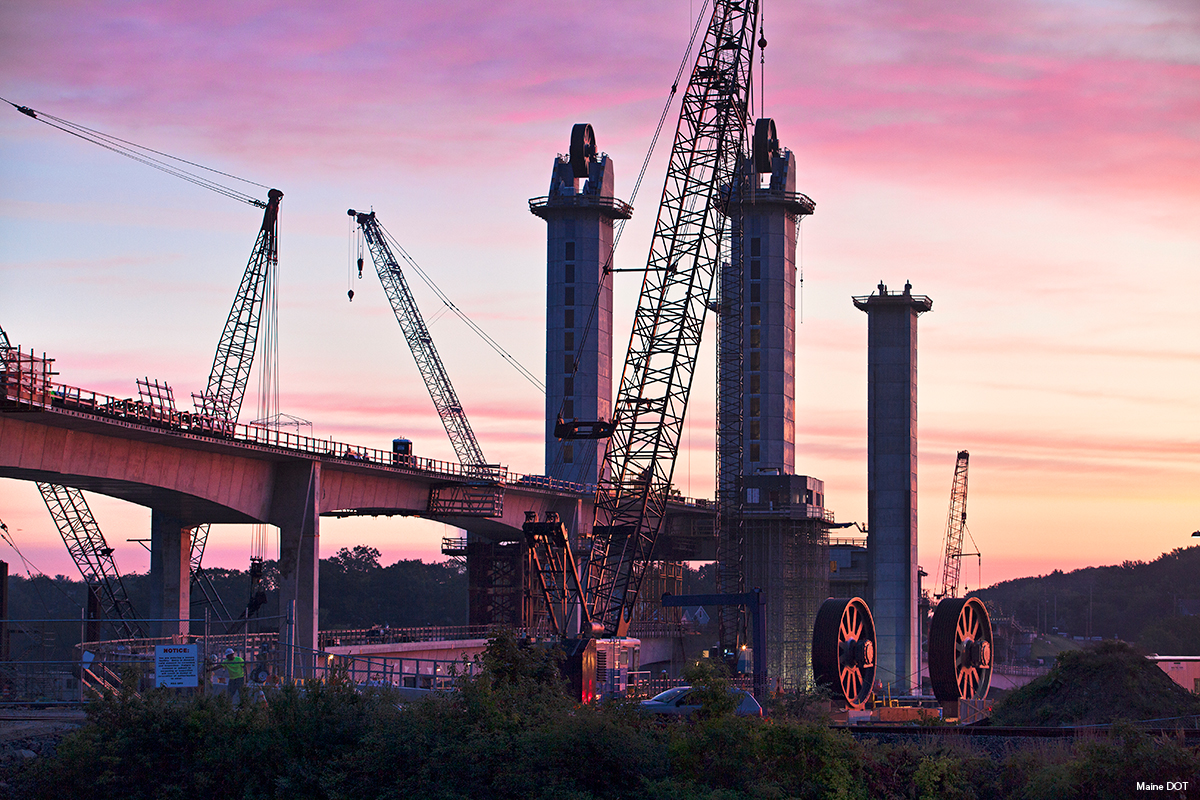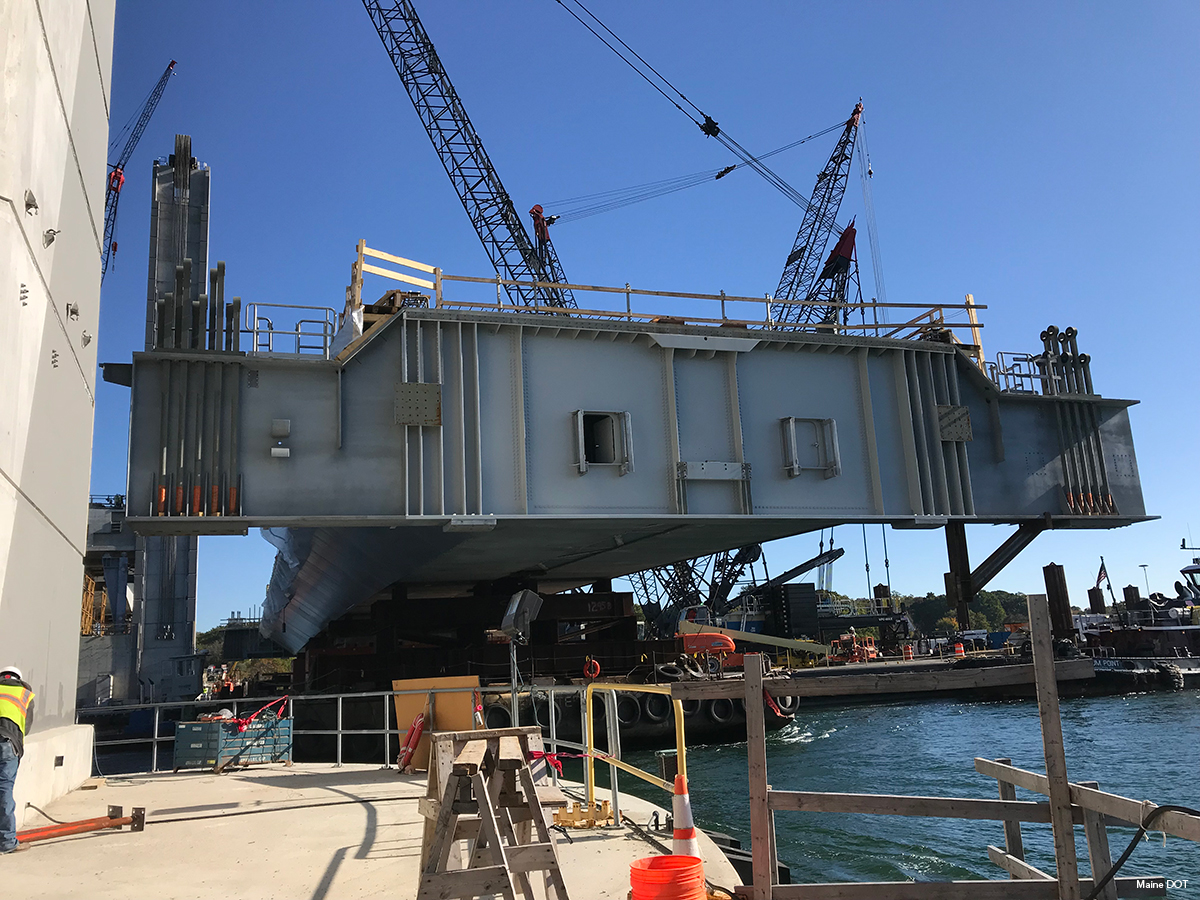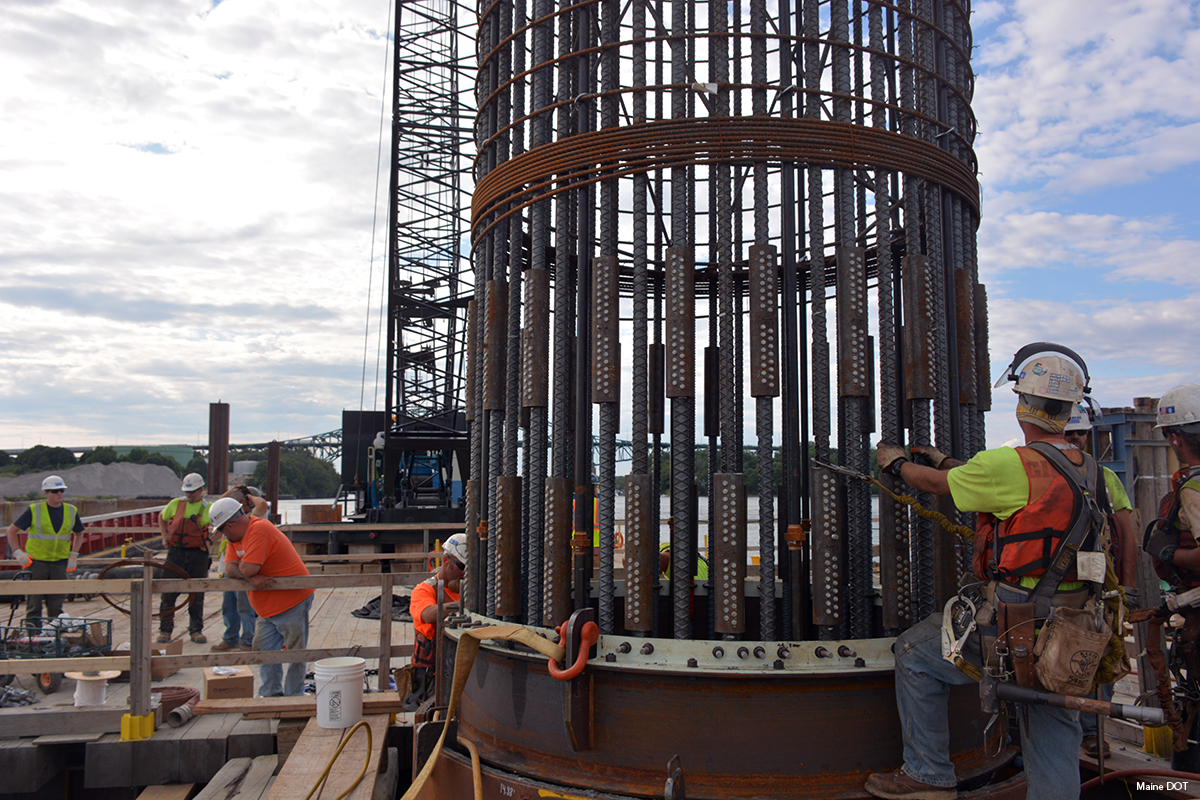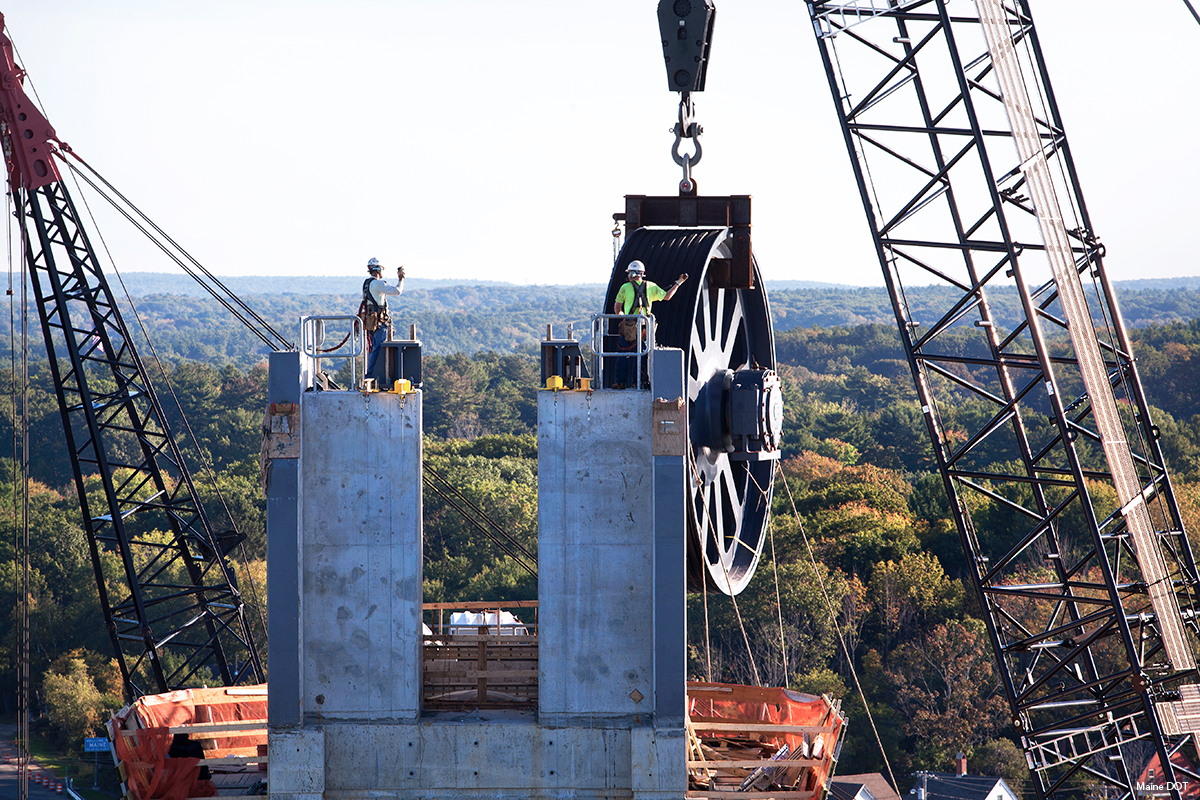National Steel Bridge Alliance
Sarah Mildred Long Bridge
National Award -- Movable Span
The new Sarah Mildred Long Bridge across the Piscataqua River between Portsmouth, N.H., and Kittery, Maine, replaces an existing span built in 1940.
Where the original bridge involved a bi-level lift span and approach bridge format, the new incarnation is a single-level lift span with bi-level approach spans. Both new and existing structures were designed to carry vehicular traffic (on the upper level) and rail traffic (on the lower level), with the new single-level lift span lowering for rail traffic and raising for maritime vessels.
The project is a complete bridge replacement including foundations, an operator’s room, new traffic warning systems, a new 300-ft-long steel box girder lift span, and precast post-tensioned towers and vehicular and railroad approach segments. The team contended with several challenges, such as minimizing construction costs and construction time, a swift tidal channel with a current of approximately 5 knots and a tidal change of 8 ft, and a design vessel collision force of 6,000 tons.
On the lift span itself, the rail and roadway are on the same level, with the tracks embedded in the median. Dual seating positions (vehicular and rail) allow the single-level lift span to match the bi-level approaches. Because the new bridge has a 56-ft vertical clearance when in its “resting” position (an increase in vertical clearance from the original configuration) there will be 68% fewer bridge openings than with the old bridge, significantly reducing the number of traffic delays. The lift span is simply lowered down to match up with the railroad bridge approaches on the relatively rare occasion when trains travel across the river.
The lift span superstructure uses a traditional twin steel tub girder design with a continuous top plate to facilitate shipping to the site by truck. This allowed the final configuration of the lift span to be fabricated at local inland facilities then assembled on-site, reducing the construction schedule and planned existing bridge closures.
The lift span girder is a multi-box steel structure with a composite concrete deck. Based on the length-to-width ratio of the structure, the entire cross section is effective in resisting global forces. Two main boxes with separate bottom flanges, two fascia box beams, and a composite concrete deck are the primary longitudinal load carrying members. In addition to contributing to the overall cross section, the composite deck is designed to transmit local loads transversely to the main longitudinal elements. Longitudinal elements are braced at discrete points along the length of the span at 12-ft increments. Transverse elements include cantilever brackets between fascia boxes and main boxes, internal box bracing, and intermediate diaphragms along the centerline of the span between main boxes, and the lift span girder is supported at each end by transverse lifting girders.
The main boxes are aligned such that the interior webs are located directly below each rail track. The track is embedded within the concrete deck, with minimal cover to the top of the steel, and the design team implemented a direct load path into the box section. In addition to providing a predictable load path, this alignment eliminated the need for supplemental track support structures and ultimately reduced the span weight.
An innovative retractable support system was developed to support the lift span at the mid-level roadway position and move out of the way to allow the lift span to lower to the rail position. Tapered steel columns founded on spherical bearings at the rail level and cylindrical bearings at the electrical room under the roadway level rotate to allow for the dual seating of the lift span.
The fatigue critical areas of the structure are primarily located along the top flange plate when subjected to transverse loading. Fatigue analysis of the deck plate required an increased plate size along the centerline of the span, below the track and extending beyond the interior web plates. Deck plate details in the longitudinal direction are not a fatigue concern, as the flange always remains in compression.
Placing the operating machinery at the base of the tower is an innovation that is relatively recent to the movable bridge industry—and one that was implemented on the new Sarah Mildred Long Bridge. The lifting machinery, mechanical systems, and electrical systems could all be installed before completing tower erection and lift span float-in because they are placed lower in the tower. This provided for quicker construction, reduced initial costs, and allows easier access for future maintenance.
The lift span box girders and other lift span steel components were fabricated at Casco Bay Steel Structures in South Portland, Maine before being sent by rail to a waterfront facility and barged to the bridge site. Float-in was a complex operation that required a fixed guide barge, an adjacent push barge with two tugs, and a lift span overhanging barge. Several important steps followed the float-in, including deck placement, joint installation, finger joints, mitre rail, span guides, access, and rope connection.
The bridge was designed with long open spans, using 11 fewer piers than the old bridge. This span layout not only enhances vistas for residents and motorists, but it also enabled the new bridge to cross Market Street without a pier in the median. The new bridge serves as a gateway entrance into historic downtown Portsmouth.
Project Team
-
Fabricator: Casco Bay Steel Structures, Inc., South Portland, Maine *AISC MEMBER* *AISC CERTIFIED*
-
Steel erector and general contractor: Cianbro, Pittsfield, Maine *AISC MEMBER* *AISC CERTIFIED*
-
Steel detailer: Tensor Engineering, Indian Harbour Beach, Fla. *AISC MEMBER*
-
Engineer: Hardesty & Hanover, LLC, New York
-
Owners:
-
Maine Department of Transportation, Augusta, Maine
-
New Hampshire Department of Transportation, Concord, N.H.
Prize Bridge Information
- Year Awarded: 2020
- Year Completed: 2018
- Location: between Kittery, Maine and Portsmouth, N.H., ME
- Award Class: Movable Span
Structure Information
- Structure Type: Movable
- Coating System: Metalized
- Span Length (ft): 300
- Structure Length (ft): 2800
- Average Deck Width (ft): 42'7"
- Steel Weight/Deck Area (lb/ft²): 193 (lift span)
- Amount of Steel (tons): 1235 (lift span)
